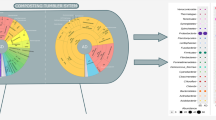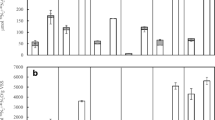Abstract
In this study, 16S rRNA- and rDNA-based denaturing gradient gel electrophoresis (DGGE) were used to study the temporal and spatial evolution of the microbial communities in a compost biofilter removing H2S and in a control biofilter without H2S loading. During the first 81 days of the experiment, the H2S removal efficiencies always exceeded 93% at loading rates between 4.1 and 30 g m−3 h−1. Afterwards, the H2S removal efficiency decreased to values between 44 and 71%. RNA-based DGGE analysis showed that H2S loading to the biofilter increased the stability of the active microbial community but decreased the activity-based diversity and evenness. The most intense band in both the RNA- and DNA-based DGGE patterns of the H2S-degrading biofilter represented the sulfur oxidizing bacterium Thiobacillusthioparus. This suggested that T. thioparus constituted a major part of the bacterial community and was an important primary degrader in the H2S-degrading biofilter. The decreasing H2S removal efficiencies near the end of the experiment were not accompanied by a substantial change of the DGGE patterns. Therefore, the decreased H2S removal was probably not caused by a failing microbiology but rather by a decrease of the mass transfer of substrates after agglutination of the compost particles.





Similar content being viewed by others
References
Boon N, De Windt W, Verstraete W, Top EM (2002) Evaluation of nested PCR-DGGE (denaturing gradient gel electrophoresis) with group-specific 16S rRNA primers for the analysis of bacterial communities from different wastewater treatment plants. FEMS Microbiol Ecol 39:101–112
Boon N, Top EM, Verstraete W, Siciliano SD (2003) Bioaugmentation as a tool to protect the structure and function of an activated-sludge microbial community against a 3-chloroaniline shock load. Appl Environ Microbiol 69:1511–1520
Bordado JCM, Gomes JFP (2002) Atmospheric emissions of Kraft pulp mills. Chem Eng Process 41:667–671
Chang YJ, Stephen JR, Richter AP, Venosa AD, Bruggemann J, Macnaughton SJ, Kowalchuk GA, Haines JR, Kline E, White DC (2000) Phylogenetic analysis of aerobic freshwater and marine enrichment cultures efficient in hydrocarbon degradation: effect of profiling method. J Microbiol Methods 40:19–31
Cho KS, Hirai M, Shoda M (1992) Degradation of hydrogen sulfide by Xanthomonas sp. strain DY44 isolated from peat. Appl Environ Microbiol 58:1183–1189
Chung YC, Huang CP, Tseng CP (1996) Biodegradation of hydrogen sulfide by a laboratory-scale immobilized Pseudomonas putida CH11 biofilter. Biotechnol Prog 12:773–778
Cole JR, Chai B, Farris RJ, Wang Q, Kulam SA, McGarrel DM, Garrity GM, Tiedje J (2005) The Ribosomal Database Project (RDP-II): sequences and tools for high-throughput rRNA analysis. Nucleic Acids Res 33 (Database Issue):D294–D296
Cook LL, Gostomski PA, Apel WA (1999) Biofiltration of asphalt emissions: full-scale operation treating off-gases from polymer-modified asphalt production. Environ Prog 18:178–187
Degorce-Dumas JR, Kowal S, Le Cloirec P (1997) Microbiological oxidation of hydrogen sulphide in a biofilter. Can J Microbiol 43:264–271
Delhomenie MC, Heitz M (2005) Biofiltration of air: a review. Crit Rev Biotechnol 25:53–72
Easter C, Quigley C, Burrowes P, Witherspoon J, Apgar D (2005) Odor and air emissions control using biotechnology for both collection and wastewater treatment systems. Chem Eng J 113:93–104
Elias A, Barona A, Rios FJ, Arreguy A, Munguira M, Penas J, Sanz JL (2000) Application of biofiltration to the degradation of hydrogen sulfide in gas effluents. Biodegradation 11:423–427
Friedrich U, Naismith MM, Altendorf K, Lipski A (1999) Community analysis of biofilters using fluorescence in situ hybridization including a new probe for the Xanthomonas branch of the class Proteobacteria. Appl Environ Microbiol 65:3547–3554
Friedrich U, Prior K, Altendorf K, Lipski A (2002) High bacterial diversity of a waste gas-degrading community in an industrial biofilter as shown by a 16S rDNA clone library. Environ Microbiol 4:721–734
Friedrich U, Van Langenhove H, Altendorf K, Lipski A (2003) Microbial community and physicochemical analysis of an industrial waste gas biofilter and design of 16S rRNA-targeting oligonucleotide probes. Environ Microbiol 5:183–201
Gellens V, Boelens J, Verstraete W (1995) Source separation, selective collection and in-reactor digestion of biowaste. Antonie Van Leeuwenhoek 67:79–89
Goodwin JP, Amenta SA, Delo RC, Del Vecchio M, Pinnette JR, Pytlar TS (2000) Odor control advances at cocomposting facility. Biocycle 41:68
Jones K, Martinez A, Rizwan M, Boswell J (2005) Sulfur toxicity and media capacity for H2S removal in biofilters packed with a natural or a commercial granular medium. J Air Waste Manage Assoc 55:415–420
Ka JO, Yu Z, Mohn WW (2001) Monitoring the size and metabolic activity of the bacterial community during biostimulation of fuel-contaminated soil using competitive PCR and RT-PCR. Microb Ecol 42:267–273
Khammar N, Malhautier L, Degrange V, Lensi R, Godon JJ, Fanlo JL (2005) Link between spatial structure of microbial communities and degradation of a complex mixture of volatile organic compounds in peat biofilters. J Appl Microbiol 98:476–490
Kim HS, Kim YJ, Chung JS, Xie Q (2002) Long-term operation of a biofilter for simultaneous removal of H2S and NH3. J Air Waste Manage Assoc 52:1389–1398
Lane DJ, Harrison AP, Stahl D, Pace B, Giovannoni SJ, Olsen GJ, Pace NR (1992) Evolutionary relationships among sulfur-oxidizing and iron-oxidizing eubacteria. J Bacteriol 174:269–278
Liu YH, Quan X, Zhao YZ, Chen S, Zhao HM (2005) Removal of ternary VOCs in air streams at high loads using a compost-based biofilter. Biochem Eng J 23:85–95
Luo J (2001) A pilot-scale study on biofilters for controlling animal rendering process odours. Water Sci Technol 44:277–285
Morgan-Sagastume JM, Noyola A, Revah S, Ergas SJ (2003) Changes in physical properties of a compost biofilter treating hydrogen sulphide. J Air Waste Manage Assoc 53:1011–1021
Muyzer G, Dewaal EC, Uitterlinden AG (1993) Profiling of complex microbial populations by denaturing gradient gel electrophoresis analysis of polymerase chain reaction-amplified genes coding for 16S ribosomal RNA. Appl Environ Microbiol 59:695–700
Oyarzun P, Arancibia F, Canales C, Aroca GE (2003) Biofiltration of high concentration of hydrogen sulphide using Thiobacillus thioparus. Process Biochem 39:165–170
Ovreas L, Forney L, Daae FL, Torsvik V (1997) Distribution of bacterioplankton in meromictic Lake Saelenvannet, as determined by denaturing gradient gel electrophoresis of PCR-amplified gene fragments coding for 16S rRNA. Appl Environ Microbiol 63:3367–3373
Pruden A, Suidan MT, Venosa AD, Wilson GJ (2001) Biodegradation of methyl tert-butyl ether under various substrate conditions. Environ Sci Technol 35:4235–4241
Sercu B, Demeestere K, Baillieul H, Verstraete W, Van Langenhove H (2005a) Degradation of isobutanal at high loading rates in a compost biofilter. J Air Waste Manage Assoc 55:1217–1227
Sercu B, Núñez D, Van Langenhove H, Aroca G, Verstraete W (2005b) Operational and microbiological aspects of a bioaugmented two-stage biotrickling filter removing hydrogen sulfide and dimethyl sulfide. Biotechnol Bioeng 90:259–269
Shannon CE, Weaver W (1963) The mathematical theory of communication. University of Illinois Press, Urbana
Smet E, Van Langenhove H (1998) Abatement of volatile organic sulfur compounds in odorous emissions from the bio-industry. Biodegradation 9:273–284
Smet E, VanLangenhove H, Verstraete W (1997) Isobutyraldehyde as a competitor of the dimethyl sulfide degrading activity in biofilters. Biodegradation 8:53–59
Tack FM, Lapauw F, Verloo MG (1997) Determination and fractionation of sulphur in a contaminated dredged sediment. Talanta 44:2185–2192
Teske A, Wawer C, Muyzer G, Ramsing NB (1996) Distribution of sulfate-reducing bacteria in a stratified fjord (Mariager fjord, Denmark) as evaluated by most-probable-number counts and denaturing gradient gel electrophoresis of PCR-amplified ribosomal DNA fragments. Appl Environ Microbiol 62:1405–1415
Van Langenhove H, Cornelis C, Schamp N, Wuyts E (1989) Biofiltration in vegetables processing industry. Meded Fac Landbouwwet Rijksuniv Gent 54:1471–1473
von Keitz V, Schramm A, Altendorf K, Lipski A (1999) Characterization of microbial communities of biofilters by phospholipid fatty acid analysis and rRNA targeted oligonucleotide probes. Syst Appl Microbiol 22:626–634
Wagner M, Amann R, Lemmer H, Schleifer KH (1993) Probing activated sludge with oligonucleotides specific for Proteobacteria—inadequacy of culture-dependent methods for describing microbial community structure. Appl Environ Microbiol 59:1520–1525
Wang GCY, Wang Y (1996) The frequency of chimeric molecules as a consequence of PCR co-amplification of 16S rRNA genes from different bacterial species. Microbiology 142:1107–1114
Webster TS, Devinny JS, Torres EM, Basrai SS (1997) Microbial ecosystems in compost and granular activated carbon biofilters. Biotechnol Bioeng 53:296–303
Wittebolle L, Boon N, Vanparys B, Heylen K, De Vos P, Verstraete W (2005) Failure of the ammonia oxidation process in two pharmaceutical wastewater treatment plants is linked to shifts in the bacterial communities. J Appl Microbiol 99:997–1006
Yang YH, Allen ER (1994) Biofiltration control of hydrogen sulfide. 1. Design and operational parameters. J Air Waste Manage Assoc 44:863–868
Acknowledgements
This work was supported by a scholarship from the Institute for the Promotion of Innovation through Science and Technology in Flanders (IWT-Vlaanderen) (IWT/SB/11314/Sercu). The authors acknowledge Peter Machilse at Intercommunale Grondbeleid en Expansie Antrwerpen (IGEAN) for providing the compost material, and Han Vervaeren and Robin Temmerman for critically reviewing the manuscript.
Author information
Authors and Affiliations
Corresponding author
Rights and permissions
About this article
Cite this article
Sercu, B., Boon, N., Verstraete, W. et al. H2S degradation is reflected by both the activity and composition of the microbial community in a compost biofilter. Appl Microbiol Biotechnol 72, 1090–1098 (2006). https://doi.org/10.1007/s00253-006-0382-x
Received:
Revised:
Accepted:
Published:
Issue Date:
DOI: https://doi.org/10.1007/s00253-006-0382-x




